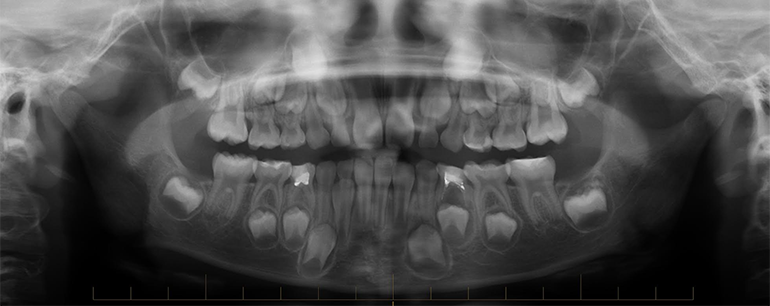OPG & Cephalogram
An Orthopantomogram, or OPG, is a special type of x-ray that takes images of the lower face, teeth, jaw joints and maxillary sinuses. The teeth are displayed in a long flat line. This x-ray is useful to demonstrate the number of teeth as well as their position and growth, and is particularly useful to assess teeth that have not yet surfaced.
A Lateral Cephalogram (or Lat Ceph) is an x-ray taken of the side of the face with very precise positioning, so that various measurements can be made to determine the current and future relationship of the top and bottom jaw (maxilla and mandible) and therefore assess the nature of a patient’s bite. This is particularly useful to plan any orthodontic treatment that may be necessary.

Preparation
No specific preparation is required for an OPG and Lat Ceph.
Pregnant?
It is important that you tell your own doctor and The Cross Radiology if there is any chance you might be pregnant. This is important information, as it will make a difference in the way the X-ray is carried out or a different test altogether might be required. Your safety and that of your unborn child is the number one priority.
Upon Arrival
You may be asked to remove your hairclips, earrings, pins, chains or other items of jewellery before the examination, as these can sometimes interfere with the X-Ray.
During the Scan
During the OPG the arm of the machine will rotate slowly around the head but will not come into contact with you. You will be instructed to bite on a small plastic mouthpiece attached to the machine, which keeps the top and bottom teeth separated and helps position the mouth properly in the machine.
For a Lateral Cephalogram you are required to hold still and bite together on the back teeth. Lips should be relaxed. The Radiographer will help, to ensure that you are in the correct position before taking the x-ray.
For the OPG and Lat Ceph, you should remain as still as possible. The whole test usually takes 5 minutes or less.
For a Lateral Cephalogram you are required to hold still and bite together on the back teeth. Lips should be relaxed. The Radiographer will help, to ensure that you are in the correct position before taking the x-ray.
For the OPG and Lat Ceph, you should remain as still as possible. The whole test usually takes 5 minutes or less.
Results
Our experienced radiologist looks at the images and sends the results to your treating doctor. You need to discuss the results with your treating doctor.
Risks
Generally, the benefit of the X-ray procedure is far more important than the small estimated risk of the effects of radiation. At the radiation dose levels that are used in diagnostic radiography, there is little or no evidence of health effects.



